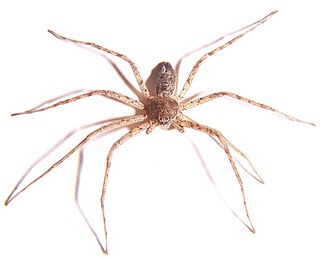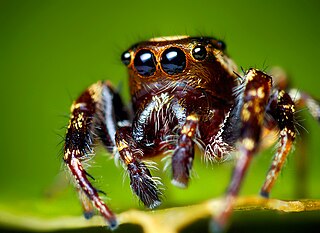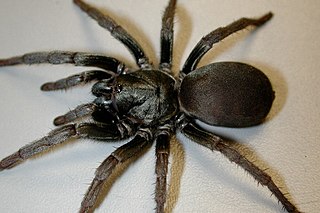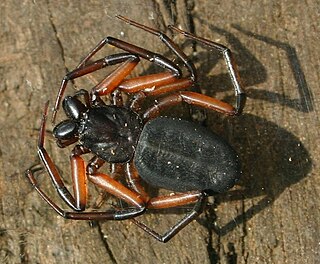
Huntsman spiders, members of the family Sparassidae, are known by this name because of their speed and mode of hunting. They are also called giant crab spiders because of their size and appearance. Larger species sometimes are referred to as wood spiders, because of their preference for woody places. In southern Africa the genus Palystes are known as rain spiders or lizard-eating spiders. Commonly, they are confused with baboon spiders from the Mygalomorphae infraorder, which are not closely related.

Philodromidae, also known as philodromid crab spiders and running crab spiders, is a family of araneomorph spiders first described by Tord Tamerlan Teodor Thorell in 1870. It contains over 500 species in thirty genera.

Corinnidae is a family of araneomorph spiders, sometimes called corinnid sac spiders. The family, like other "clubionoid" families, has a confusing taxonomic history. Once it was a part of the large catch-all taxon Clubionidae, now very much smaller. The original members of the family are apparently similar only in that they have eight eyes arranged in two rows, conical anterior spinnerets that touch and are generally wandering predators that build silken retreats, or sacs, usually on plant terminals, between leaves, under bark or under rocks.

Wandering spiders (Ctenidae) are a family of spiders that includes the Brazilian wandering spiders. These spiders have a distinctive longitudinal groove on the top-rear of their oval carapace similar to those of the Amaurobiidae. They are highly defensive and venomous nocturnal hunters. Despite their notoriety for being dangerous, only a few members of Phoneutria have venom known to be hazardous to humans, but the venoms of this family are poorly known, so all larger ctenids should be treated with caution.

Eris is a genus of the spider family Salticidae. It is native to North and South America. As is typical for salticids, they are not defensive. While larger specimens could potentially bite, an envenomation would pose no danger to a human.

Thiania is a genus of jumping spiders that was first described by Carl Ludwig Koch in 1846.

Nemesiidae, also known as funnel-web trapdoor spiders, is a family of mygalomorph spiders first described by Eugène Simon in 1889, and raised to family status in 1985. Before becoming its own family, it was considered part of "Dipluridae".

Trochanteriidae is a family of spiders first described by Ferdinand Karsch in 1879 containing about 180 species in 21 genera. Most are endemic to Australia though Doliomalus and Trochanteria are from South America and Olin and Plator are from Asia. Platyoides species exist in southern and eastern Africa, Madagascar, and the Canary Islands with one species, P. walteri, introduced to Australia.

Diaea is a genus of crab spiders first described by Tamerlan Thorell in 1869. Most species are found in specific locations except for D. livens, which occurs in the United States and D. dorsata, which has a palearctic distribution. Adults are 5 millimetres (0.20 in) to 7 millimetres (0.28 in) and tend to hide in and around vegetation, especially flowers, where their color allows them to blend in to their surroundings.

Hogna is a genus of wolf spiders with more than 200 described species. It is found on all continents except Antarctica.

Tarantulas comprise a group of large and often hairy spiders of the family Theraphosidae. As of August 2022, 1,040 species have been identified, with 156 genera. The term "tarantula" is usually used to describe members of the family Theraphosidae, although many other members of the same infraorder (Mygalomorphae) are commonly referred to as "tarantulas" or "false tarantulas". Some of the more common species have become popular in the exotic pet trade. Many New World species kept as pets have setae known as urticating hairs that can cause irritation to the skin, and in extreme cases, cause damage to the eyes.
Ferdinand Anton Franz Karsch or Karsch-Haack was a German arachnologist, entomologist and anthropologist.

Bassaniana, commonly called bark crab spiders, is a widespread genus of crab spiders that was first described by Embrik Strand in 1928.

Acanthogonatus is a genus of South American mygalomorph spiders in the family Pycnothelidae. It was first described by Ferdinand Anton Franz Karsch in 1880. Originally placed with the brushed trapdoor spiders, it was transferred to the funnel-web trapdoor spiders in 1985, then to the Pycnothelidae in 2020.

Thaida is a genus of South American cribellate araneomorph spiders in the family Austrochilidae, first described by Ferdinand Karsch in 1880. As of April 2019 it contains only two species in Chile and Argentina.
Corinnomma is a genus of African and Asian corinnid sac spiders first described by Ferdinand Karsch in 1880.
Adcatomus is a genus of South American huntsman spiders that was first described by Ferdinand Anton Franz Karsch in 1880. As of September 2019 it contains two species, found in Peru and Venezuela: A. ciudadus and A. flavovittatus.
Pedinopistha is a genus of Hawaiian running crab spiders that was first described by Ferdinand Anton Franz Karsch in 1880.

Mecaphesa is a genus of crab spiders that was first described by Eugène Louis Simon in 1900.















